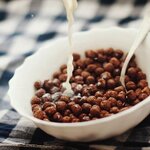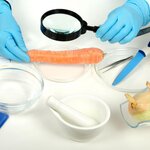Chemistry

With Valentine's Day this weekend, we will be treated to articles called things 'the science of kissing', 'the science of love', 'the science of attraction' - you name it and someone in the social sciences is capitalizing on the fuzzy nature of romance to attract some eyeballs.
Love at first sight has long been discussed but is there love at first smell?
Can you get love in a spray bottle? Kate Upton is going to be around a lot of smelly men this week, if so. Credit: The American Chemical Society
If you will buy it, someone will sell it. There are hundreds of spray-on pheromone…

Both
the European Food Safety Authority (EFSA) and the U.S. Food and Drug
Administration (FDA) have recently released assessments that strongly support
the safety of bisphenol A (BPA).
In both
cases, a body of studies documenting 1) low exposure, primarily from the diet; 2)
efficient metabolism as BPA is absorbed in the gut; and 3) rapid elimination
from the body provide key support for the safety conclusions. In contrast, a recent hypothesis suggests
that BPA in food may be absorbed through tissues in the mouth during eating,
which would avoid the efficient metabolism that…
Wine has gotten more than its share of Miracle Product mainstream media coverage so it's no surprise that beer has been left behind - smooth, balanced beers, the kind of thing that made large brands famous, are out of fashion and now everyone wants hoppy drinks, or something else wildly exaggerated.
But beer has always been a science favorite. Sometimes you hear of breakthroughs being celebrated with a bottle of Mogen David, though it is rare.
Beer needs some science and medicine rehabilitation and it may come soon, thanks to research in the Journal of Agricultural and Food Chemistry. It also…

Coating the mouth with foods stored in containers that used bisphenol A
(BPA), like soup, does not lead to high levels of BPA in blood.
BPA is used to make some plastics and to seal canned food containers against bacterial contamination. Food which picks up trace amounts of BPA from packaging is the major source of human exposure, according to environmental critics, and the health concerns about BPA center on potential to mimic certain hormones at really high exposures.
However, within the last month, the European Food Safety Authority and the U.S. Food and Drug Administration reaffirmed…

Phthalates are chemicals that increase the softness and flexibility of plastic. Due to concerns about potential health problems, the US government has permanently banned three types of phthalates (DEHP, DBP, BBP)1 in any amount greater than 0.1 percent for each phthalate in children's toys and for some child care items used for toddlers ages 3 and under.
Manufacturers have been turning to alternative plasticizers, which are different phthalates, but outside the ordinary approval process little is known about the toxicity of the replacements or whether they can enter the air infants…

Do consumers make different choices based on the fragrance surrounding them? If they do not, a billion dollar advertising segment would disappear. Studies have found, for example, that lavender is the fragrance of trust and groups are always working to improve the ambiance of the marketplace.
A new study in the Journal of Marketing says that the “temperature” of scents in a store atmosphere may have a powerful effect on what and how much customers buy. So if you want people to spend money, spread the cinnamon around.
Researchers conducted several experiments to test how warm and…

It's become a fad for nutritionists to claim that oranges are better than orange juice, and they list numerous reasons - from added sugar in juice to better uptake of carotenoids, flavonoids and Vitamin C in whole oranges.
But how different are they? Unless you are someone on a nutrition website selling the lifestyle and health fad of the moment, not much. It is true that some juices have more sugar but that is offset by the biological fact nutrients in orange juice seem to be easier for the body to absorb from juice than when a person consumes them from unprocessed fruit.
And…

By Ian Musgrave, Senior lecturer in Pharmacology at University of Adelaide.
A paper has just been released that will raise health concerns about Bisphenol A again. The paper, “Low-dose exposure to bisphenol A and replacement bisphenol S induces precocious hypothalamic neurogenesis in embryonic zebrafish” was published in the Proceedings of the National Academy of Sciences. This is a very interesting paper, but in terms of implications for human health everything hinges on what “low dose” means.
Bisphenol A (BPA) is a chemical widely used in the manufacture of plastics, is present as a…

Some alternative 'milk' products are startlingly low on nutrition and many are packed with additives despite their 'natural' tag. Iryna Yeroshko/, CC BY-SA
By Suzie Ferrie, University of Sydney
There’s a milk revolution going on in supermarkets and it’s showing no sign of retreat. Where formerly we might have had a simple choice between cow milk and soy milk, with a few other niche products available in the bigger supermarkets, suddenly we’re facing a bewildering range: almond or macadamia milk? Cow, sheep, or goat? Coconut? Rice, oat or quinoa?
But why?
First, let’s take a moment to reflect…

Bisphenol A, known as BPA, is in the middle of an environmental culture war and a hurriedly-rushed replacement, Bisphenol S (BPS), is just as big a concern.
We need plastic, food items are covered in plastic to make them last longer and protect them from microbes, but we know that plastic bottles and films take between 100 and 400 years to degrade, so the quest for alternative materials to plastics has been ongoing. That means we should not rush to embrace things just because they are 'not BPA', which still has no evidence of harm (unless hyperactive zebrafish count).
Science will solve it,…